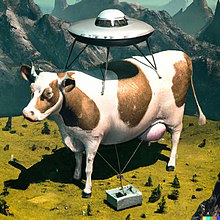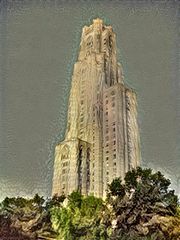人工智慧艺术

人工智慧艺术,通称AI艺术,是指通过使用人工智慧创造的任何艺术品。
工具及流程
[编辑]图像
[编辑]创造人工智慧艺术的方式共有多种方法,包括使用数码模式的程序“基于规则”的图像生成、模拟笔触和其他绘画效果的算法,以及人工智慧或深度学习算法等。
最早的重要人工智慧艺术系统之一是AARON,由哈罗德·科恩于1960年代末开始开发[1]。 AARON也是符号人工智慧艺术最著名的例子,该系统使用基于符号规则的方法来生成技术图像。科恩最初开发AARON的目的,则是令人工智慧能够对绘图行为进行编码。AARON先是以原始形式创作简单的黑白图画。后来再通过科恩绘画以完成图画。[2] 此后,他还开始为AARON开发一种绘画方式。在无需后续人工调解的方式下,科恩特地将AARON设计仅令使用程序本身选择的特殊画笔和染料从而进行绘画。[3]
自2014年开始,生成对抗网络(GAN)经常被AI艺术家所使用。该系统能够使用“生成器”来创建新图像,并使用“鉴别器”来决定哪些创建的图像被认为是成功的。[4]最近的模型则使用向量量化生成,以对抗网络和对比文笔-图像生成训练(VQGAN+CLIP)。[5]
Google于2015年发布的DeepDream,则是使用卷积神经网络通过算法错视,以查找和增强图像中的模式,从而创建故意过度处理的图像。 在DeepDream发布后,几家公司也发布了可以将照片转换为具有知名画集风格艺术图像的应用程式。[6][7]
文本到图像模型
[编辑]几个AI制图程序透过各种文本提示工程以生成各种图像。包括OpenAI的DALL-E、 谷歌大脑的Imagen和Parti(2022年5月发布)以及微软的NUWA-Infinity。[8][9][10]其输入形式还可以包括图像和关键字和/或配置参数,例如通常通过关键短语输入艺术风格,例如“in the style of {name of an artist}”的提示,或著是/广泛的审美/艺术风格元素的选择。[11]
当前,也日益出现其他AI艺术的生成程序,包括简单面向消费者的移动应用程式和Jupyter笔记本,不过多数程序需要强大的图形处理器才能有效运行。其知名案例则包括Midjourney、StyleGAN和Stable Diffusion等。2022年8月22日,Stable Diffusion正式发布[12][13][14][15],使该程序的技术更容易获得且可以在个人硬件上免费使用,也可以由第三方程式(即其他项目)扩展。这使得来自世界各地的开发人员,能够进一步创新应用程式和扩展。例如运用于Krita的插件[16]、Adobe Photoshop、Blender和GIMP等自由图像软件。[17][18][19]
Automatic1111 Stable Diffusion UI是一种基于网络的开源用户界面,用于让用户在自己的电脑上使用工具,包括不断集成的AI算图新功能(例:修复或文本反转)Stability.ai 的网络界面,允许在没有任何新安装的情况下运行DreamStudio软件。[20][21]
影响和应用
[编辑]

2022年8月,一幅网名为Sincarnate的用户使用Midjourney生成的画作,在美国科罗拉多州博览会夺下Fine Arts Exhibition数码艺术首奖。[22][23]
对此,一位专家得出结论认为:“人工智慧艺术现在已经无处不在,甚至连专家都不知道这意味着什么。”[24],一家新闻媒体则以“人工智慧产生的艺术繁荣”为报导主题[25],并采访对于著作权、人工智慧自动化问题表示意见的专业艺术家们[26],一家新闻媒体则调查网络社区面对此类艺术品的反应,并对人工智慧艺术及深伪技术的持续发展表示担忧[27],一家杂志则是强调人工智慧技术“在实现新艺术形式”的“可能性表达”,并指出该技术可能被视为一种“人类能力上的增强”[28] 。其例子包括允许业余爱好者制作扩展非商业利基类型的作品(常见例子为赛博庞克派生品)、或是产生新颖的娱乐、能够非常快速的时间制作艺术原型,能够提升生成草稿、灵感、草稿改进和图像的时间。[29][30][31]
不过,当前一些艺术网站正在禁止AI生成或AI辅助的艺术,尽管有些平台,如Pixiv则允许发布,但仍必须要将该艺术被标记为AI艺术。[32][33][34]
包括AI艺术在内的合成媒体,也在2022年被描述为影响未来几年业务的主要技术驱动趋势。
提示工程和共享
[编辑]有一些平台可以共享、交易、搜索、分叉/精炼和或是协作,以协助图像生成器借由提示生成特定图像。[35][36][37]该提示通常与图像共享网站(例如 reddit和AI艺术专用网站)上共享。
应用程式
[编辑]正在开发、具有现有原型或已经使用人工智慧艺术的应用程式还包括:
- 图片库、摄影(定制)[30]
- 产品摄影[38][39]
- 自制纸牌游戏、桌面游戏、漫画[40]、书籍封面和专辑封面[31][41]
- 动画和影像做作品(包括文本)[30][42][16][43][44]
- 低分辨率图像的高清艺术作品(例如像素艺术/复古游戏角色或模糊图像)、草稿、低质量图像(例如儿童艺术) [19][45]
- 从重新输入(如照片)以创造更多、更好的作品,或是一般派生作品的艺术[46]
- 修复,作为替换(或删除)图像中的内容,或向未完成的图像添加新要素或是扩展元素。
- 自然语言生成图像,根据用户提供的图片,参考原图的风格和元素,延伸绘制图片之外的内容。[47]
- 游戏模型创建(纹理、3D模型、角色设计等)[48][49][50][16][13]
发展
[编辑]当前,人工智慧艺术的其他功能仍在开发中,开发工作室经常改进各种应用程式或激活新功能,例如“文本反转”是指激活从少数图像中学习的用户提供的概念(如对像或样式)[51][52] 。通过文本倒置,可以从关系的词(已分配学习的、通常是抽象概念的关键字)对于原型扩展/微调(其案例包括DreamBooth)。
由人工智慧生成的图像[53] ,有时能够用作草图、低成本实验、或概念验证阶段构想的说明[54],附加功能或改进也可以在图像生成后由用户自行手动编辑,进行修改。在Stable Diffusion的情况下,主要的预先训练模型,基本在使用机器学习构建应用程式的工具平台Hugging Face Hub上共享。[55]
音乐
[编辑]人工智慧艺术领域的一个关键部分,是音乐和人工智慧之间的关系,至今的人工智慧技术能够开发使用AI制作音乐的软件程序。[56]
与其他领域的应用一样,音乐中的AI也能模拟脑力任务。一个突出的特点是,人工智慧算法能够根据过去的数据进行学习,比如在电脑伴奏技术中,人工智慧能够听取人类表演者的演奏并进行伴奏。人工智慧还推动了交互式作曲技术,电脑能够根据现场表演创作音乐。音乐领域还有其他人工智慧应用,不仅涵盖音乐创作、制作和表演,还涵盖整个音乐的营销和消费方式。如开发了几种音乐播放器程序,以使用语音识别和自然语言处理技术,以进行音乐语音的控制。
人工智慧可用于可调节地生成新颖的声音样本,艺术家可以将其用于音乐曲目。
其他
[编辑]一些原型机器人可以创造被认为是人工智慧艺术形式的作品。[57]除了文案编辑之外,还有部分AI程序也能辅助写作[58](包括对于虚构故事的生成,帮助作家在脑闭塞、没有灵感或重写片段)。[59][60][61][62]
人工智慧艺术可以用于游戏视觉艺术,特别是用于关卡设计(例如自定义地图、游戏模块)和在影像游戏中创建新内容或交互故事。[63][64]
销售
[编辑]2018年,佳士得纽约拍卖行举办了一场人工智慧艺术品拍卖会,其中艺术品《埃德蒙德贝拉米》以432,500美元的价格售出,比其估价7,000至10,000美元高出近45倍。这件艺术品是由总部位于巴黎的团体“Obvious”创作的。[65][66][67][68]
2022年9月,深度学习文生图模型Stable Diffusion和Midjourney推出插画集《Artificial AI Art Collection by Images Midjourney / Stable Diffusion》,该书籍共有104页。是日本第一部完全由AI生成的绘画作品组成的插画集。[69]
批评和问题
[编辑]
著作权问题
[编辑]自从艺术家在20世纪开始使用人工智慧创作艺术以来就引发了许多争论。2020年代,其中一些争论涉及人工智慧艺术是否可以被定义为真正的艺术以及它对艺术家的影响。[70][71][72]
1985年,潘蜜拉·萨缪尔森考虑了与著作权相关的AI艺术作者身份相关的法律问题:当人工智慧创作艺术作品时,谁拥有著作权?[73]在萨缪尔森的文章中,则认为将从于电脑生成的作品中分配所有权,认为权利应该分配给进行生成程序的用户。维克多·宫(Victor Palace)[74]则提出了三种可能的选择。首先,若是人工智慧本身成为著作权所有者。为此需要修改著作权法第101条,将“作者”定义为自然人或电脑。其次,按照萨缪尔森的论点,用户、程序员或人工智慧公司也是著作权所有者。这将是“雇佣作品”学说的扩展,根据该学说,著作权的所有权将会转移给“雇主”。最中没有人成为著作权所有者,该作品将会自动进入公有领域。该论点认为,因为没有人‘创造’了这件艺术品,所以没有人应该是著作权所有者。
英国公司设计与艺术家著作权协会的雷玛·赛尔希(Reema Selhi)于2022年9月表示:“没有任何保障措施,可以让艺术家能够识别数据库中正在使用的作品并选择退出。”。[75]
2019年8月,美国著作权局就曾驳回人工智慧艺术的著作权申请,理由为“欠缺支持著作权宣称所需的人类著作人(human authorship)”[76]。2023年2月,美国著作权局在回应人工智慧制作漫画书《黎明的札莉雅》的著作权问题时,再次提到“非人类创作”的图像无法获得著作权,但是漫画的故事和图片编排属于著作权保护范围[77]。
技术性失业问题
[编辑]一些艺术家在2022年对人工智慧艺术可能对其商业能力产生的影响表示担忧,特别是可能将被人工智慧取代从事插画和设计的艺术家。[78][79]据英国工会Equity称:共有“65%的表演者认为,人工智慧技术的发展对表演艺术领域的就业机会构成威胁。”[80]
数码艺术家RJ·帕默(RJ Palmer)表示:“我可以很容易地设想这样一个场景,即使用 AI,单个艺术家或艺术总监便可以取代约5-10名入门级艺术家……我见过很多自行出版的作者,他们说如果他们因为AI技术的存在,因而再也不必聘请艺术家。”同时帕默补充说道:“为小型创作者做这种工作,是我们中的许多人开始成为专业艺术家的方式。”[81]波兰数码艺术家格雷格·鲁特科夫斯基(Greg Rutkowski)则表示:“它一开始看起来像是对我们职业的威胁”,并补充可能使用户在搜索艺术家的作品变得越来越困难,透过搜索引擎许多图像,可能也会出现提示模仿他的风格而生成的AI作品。[82]
深度造假问题
[编辑]自19世纪出现修饰照片技术以来,21世纪初的一些人士一直担心人工智慧艺术可能被用来创建具有误导性的内容,即所谓的“深伪技术”的风险。[27]
图片
[编辑]-
一位浑身湿透的太空人,撑著一把白色的雨伞在月球表面的倾盆大雨中行走的作品
-
机械鸽子
-
一个孤独的蓝色男子,以胎儿的姿态蜷缩在虚无中
-
耶稣基督在大麻田上的图像
-
威尼斯受到轰炸的模拟图像
-
森林。
-
AI生成的赛博庞克城市景观艺术
-
以神经风格所绘制的摩天大楼
另见
[编辑]参考资料
[编辑]- ^ McCorduck, Pamela. AARONS's Code: Meta-Art. Artificial Intelligence, and the Work of Harold Cohen. New York: W. H. Freeman and Company. 1991: 210. ISBN 0-7167-2173-2 (English).
- ^ Poltronieri, Fabrizio Augusto; Hänska, Max. Technical Images and Visual Art in the Era of Artificial Intelligence: From GOFAI to GANs. Proceedings of the 9th International Conference on Digital and Interactive Arts (Braga Portugal: ACM). 2019-10-23: 1–8 [2022-12-05]. ISBN 978-1-4503-7250-3. doi:10.1145/3359852.3359865. (原始内容存档于2022-09-29) (英语).
- ^ Fine art print - crypto art. Kate Vass Galerie. [2022-05-07]. (原始内容存档于2022-07-22) (美国英语).
- ^ Goodfellow, Ian; Pouget-Abadie, Jean; Mirza, Mehdi; Xu, Bing; Warde-Farley, David; Ozair, Sherjil; Courville, Aaron; Bengio, Yoshua. Generative Adversarial Nets (PDF). Proceedings of the International Conference on Neural Information Processing Systems (NIPS 2014): 2672–2680. 2014 [2022-12-05]. (原始内容存档 (PDF)于2019-11-22).
- ^ Burgess, Phillip. Generating AI “Art” with VQGAN+CLIP. Adafruit. [July 20, 2022]. (原始内容存档于2022-09-28).
- ^ A.I. photo filters use neural networks to make photos look like Picassos. Digital Trends. 18 November 2019 [9 November 2022]. (原始内容存档于2022-11-09) (英语).
- ^ Biersdorfer, J. D. From Camera Roll to Canvas: Make Art From Your Photos. The New York Times. 2019-12-04 [2025-01-14]. ISSN 0362-4331 (美国英语).
- ^ NUWA-Infinity. nuwa-infinity.microsoft.com. [2022-08-10]. (原始内容存档于2022-12-06).
- ^ Vincent, James. All these images were generated by Google’s latest text-to-image AI. The Verge (Vox Media). May 24, 2022 [May 28, 2022]. (原始内容存档于2023-02-15).
- ^ Khan, Imad. Google's Parti Generator Relies on 20 Billion Inputs to Create Photorealistic Images. CNET. [23 June 2022]. (原始内容存档于2022-11-08).
- ^ Proulx, Natalie. Are A.I.-Generated Pictures Art?. September 2022 [16 November 2022]. (原始内容存档于2023-02-06).
- ^ Stable Diffusion. CompVis - Machine Vision and Learning LMU Munich. 15 September 2022 [15 September 2022]. (原始内容存档于2023-02-15).
- ^ 13.0 13.1 Choudhary, Lokesh. Stable Diffusion, a milestone?. Analytics India Magazine. 1 September 2022 [9 November 2022]. (原始内容存档于2022-11-09).
- ^ Stable Diffusion: Warum KI-generierte Bilder bald wirklich überall sind. t3n.de. [9 November 2022]. (原始内容存档于2022-11-09) (德语).
- ^ Roose, Kevin. A Coming-Out Party for Generative A.I., Silicon Valley’s New Craze. The New York Times. 21 October 2022 [9 November 2022]. (原始内容存档于2023-02-15).
- ^ 16.0 16.1 16.2 Choudhary, Lokesh. These new innovations are being built on top of Stable Diffusion. Analytics India Magazine. 23 September 2022 [9 November 2022]. (原始内容存档于2022-11-09).
- ^ published, Dave James. I thrashed the RTX 4090 for 8 hours straight training Stable Diffusion to paint like my uncle Hermann. PC Gamer. 27 October 2022 [9 November 2022]. (原始内容存档于2022-11-09) (英语).
- ^ Lewis, Nick. How to Run Stable Diffusion Locally With a GUI on Windows. How-To Geek. [9 November 2022]. (原始内容存档于2023-01-23).
- ^ 19.0 19.1 Edwards, Benj. Begone, polygons: 1993’s Virtua Fighter gets smoothed out by AI. Ars Technica. 4 October 2022 [9 November 2022]. (原始内容存档于2023-02-01) (美国英语).
- ^ Fleischer, Jan. Text-zu-Bild-Wandler für daheim. scinexx | Das Wissensmagazin. 7 September 2022 [9 November 2022]. (原始内容存档于2022-12-16) (de-DE).
- ^ Stable Diffusion creator Stability AI accelerates open-source AI, raises $101M. VentureBeat. 18 October 2022 [10 November 2022]. (原始内容存档于2023-01-12).
- ^ 4Gamers. AI繪圖「Midjourney」作品參加美術展獲獎,引發藝術家不滿. 4Gamers 官方网站. [2022-12-05]. (原始内容存档于2022-12-05) (中文(繁体)).
- ^ An AI-Generated Artwork Won First Place at a State Fair Fine Arts Competition, and Artists Are Pissed. Vice. [15 September 2022]. (原始内容存档于2022-11-14) (英语).
- ^ Ocampo, Rodolfo. AI art is everywhere right now. Even experts don't know what it will mean. techxplore.com. [15 September 2022]. (原始内容存档于2023-01-19) (英语).
- ^ As AI-generated art takes off - who really owns it?. Thomson Reuters Foundation. [15 September 2022]. (原始内容存档于2022-09-23).
- ^ Edwards, Benj. Flooded with AI-generated images, some art communities ban them completely. Ars Technica. 12 September 2022 [15 September 2022]. (原始内容存档于2023-01-31) (美国英语).
- ^ 27.0 27.1 Wiggers, Kyle. Deepfakes: Uncensored AI art model prompts ethics questions. TechCrunch. 24 August 2022 [15 September 2022]. (原始内容存档于2022-08-31).
- ^ AI is reshaping creativity, and maybe that's a good thing. Dazed. 18 August 2022 [15 September 2022]. (原始内容存档于2023-01-23) (英语).
- ^ AI-generated art illustrates another problem with computers | John Naughton. The Guardian. 20 August 2022 [15 September 2022]. (原始内容存档于2023-02-06) (英语).
- ^ 30.0 30.1 30.2 Elgan, Mike. How ‘synthetic media’ will transform business forever. Computerworld. 1 November 2022 [9 November 2022]. (原始内容存档于2023-02-10) (英语).
- ^ 31.0 31.1 Vincent, James. Anyone can use this AI art generator — that’s the risk. The Verge. 15 September 2022 [9 November 2022]. (原始内容存档于2023-02-14).
- ^ Robertson, Adi. How DeviantArt is navigating the AI art minefield. The Verge. 15 November 2022 [16 November 2022]. (原始内容存档于2023-01-04).
- ^ DeviantArt's AI image generator aims to give more power to artists. Popular Science. 12 November 2022 [16 November 2022]. (原始内容存档于2023-02-03).
- ^ 4Gamers. 不排斥AI創作,Pixiv將設立AI生成作品專屬排行榜. 4Gamers 官方网站. [2022-12-05]. (原始内容存档于2022-12-05) (中文(繁体)).
- ^ Davenport, Corbin. This AI Art Gallery Is Even Better Than Using a Generator. How-To Geek. [9 November 2022]. (原始内容存档于2022-12-27).
- ^ Robertson, Adi. Professional AI whisperers have launched a marketplace for DALL-E prompts. The Verge. 2 September 2022 [9 November 2022]. (原始内容存档于2023-02-15).
- ^ Text-zu-Bild-Revolution: Stable Diffusion ermöglicht KI-Bildgenerieren für alle. heise online. [9 November 2022]. (原始内容存档于2023-01-29) (德语).
- ^ Djudjic, Dunja. PhotoRoom uses AI to turn your lousy snapshots into decent product photos. DIY Photography. 8 November 2022 [9 November 2022]. (原始内容存档于2022-12-02) (美国英语).
- ^ Venugopal, Sahana. Playground is a hybrid art generator with urgent safety concerns. The Hindu. 18 October 2022 [9 November 2022]. (原始内容存档于2022-12-30) (印度英语).
- ^ Katz, Leslie. This Comic Series Is Gorgeous. You'd Never Know AI Drew the Whole Thing. CNET. [16 November 2022]. (原始内容存档于2022-11-16) (英语).
- ^ Anderson, Pearse. Can AI art democratize tabletop game publishing?. Polygon. 16 September 2022 [9 November 2022]. (原始内容存档于2022-12-07).
- ^ Edwards, Benj. Runway teases AI-powered text-to-video editing using written prompts. Ars Technica. 9 September 2022 [9 November 2022]. (原始内容存档于2023-01-27) (美国英语).
- ^ Edwards, Benj. Google’s newest AI generator creates HD video from text prompts. Ars Technica. 5 October 2022 [9 November 2022]. (原始内容存档于2023-02-07) (美国英语).
- ^ How diffusion models unlock new possibilities for generative creativity. VentureBeat. 26 October 2022 [9 November 2022]. (原始内容存档于2022-12-04).
- ^ Edwards, Benj. Pixel art comes to life: Fan upgrades classic MS-DOS games with AI. Ars Technica. 1 September 2022 [9 November 2022]. (原始内容存档于2023-02-04) (美国英语).
- ^ Growcoot, Matt. Photographer Accurately Recreates his Work with AI Image Generator. PetaPixel. 10 November 2022 [16 November 2022]. (原始内容存档于2022-12-26) (英语).
- ^ DALL-E can now help you imagine what's outside the frame of famous paintings. The Verge. [15 September 2022]. (原始内容存档于2022-10-07).
- ^ NVIDIA's new AI model quickly generates objects and characters for virtual worlds. Engadget. [9 November 2022]. (原始内容存档于2022-12-20).
- ^ GET3D: A Generative Model of High Quality 3D Textured Shapes Learned from Images. nv-tlabs.github.io. [9 November 2022]. (原始内容存档于2023-01-27).
- ^ Lewis, Nick. How to Make a Minecraft Texture Pack With Stable Diffusion. How-To Geek. [9 November 2022]. (原始内容存档于2022-12-09).
- ^ Gal, Rinon; Alaluf, Yuval; Atzmon, Yuval; Patashnik, Or; Bermano, Amit H.; Chechik, Gal; Cohen-Or, Daniel. An Image is Worth One Word: Personalizing Text-to-Image Generation using Textual Inversion. 2 August 2022. arXiv:2208.01618
 [cs.CV].
[cs.CV].
- ^ Textual Inversion · AUTOMATIC1111/stable-diffusion-webui Wiki. GitHub. [9 November 2022]. (原始内容存档于2023-02-07) (英语).
- ^ Roose, Kevin. A.I.-Generated Art Is Already Transforming Creative Work. The New York Times. 21 October 2022 [16 November 2022]. (原始内容存档于2023-02-15).
- ^ Leswing, Kif. Why Silicon Valley is so excited about awkward drawings done by artificial intelligence. CNBC. [16 November 2022]. (原始内容存档于2023-02-08) (英语).
- ^ Mehta, Sourabh. How to Generate an Image from Text using Stable Diffusion in Python. Analytics India Magazine. 17 September 2022 [16 November 2022]. (原始内容存档于2022-11-16).
- ^ Yalalov, Damir. StabilityAI announced AI Music Generator Harmonai based on Dance Diffusion Model. Metaverse Post. 3 October 2022 [9 November 2022]. (原始内容存档于2022-11-30).
- ^ Sochacki, Grzegorz; Abdulali, Arsen; Iida, Fumiya. Mastication-Enhanced Taste-Based Classification of Multi-Ingredient Dishes for Robotic Cooking. Frontiers in Robotics and AI. 2022, 9: 886074. ISSN 2296-9144. PMC 9114309
 . PMID 35603082. doi:10.3389/frobt.2022.886074
. PMID 35603082. doi:10.3389/frobt.2022.886074  .
.
- News release: Taste of the future: Robot chef learns to 'taste' as it goes. University of Cambridge. [2022-12-05]. (原始内容存档于2022-12-05) (英语).
- ^ Katsnelson, Alla. Poor English skills? New AIs help researchers to write better. Nature: 208–209. 29 August 2022 [16 November 2022]. doi:10.1038/d41586-022-02767-9. (原始内容存档于2022-12-18) (英语).
- ^ KoboldAI/KoboldAI-Client. 9 November 2022 [9 November 2022]. (原始内容存档于2023-02-04).
- ^ Dzieza, Josh. Can AI write good novels?. The Verge. 20 July 2022 [16 November 2022]. (原始内容存档于2023-02-10).
- ^ AI Writing Assistants: A Cure for Writer's Block or Modern-Day Clippy?. PCMAG. [16 November 2022]. (原始内容存档于2023-01-23) (英语).
- ^ Song, Victoria. Google’s new prototype AI tool does the writing for you. The Verge. 2 November 2022 [16 November 2022]. (原始内容存档于2023-02-07).
- ^ Yannakakis, Geogios N. Game AI revisited. Proceedings of the 9th conference on Computing Frontiers. CF '12 (New York, NY, USA: Association for Computing Machinery). 2012-05-15: 285-292. ISBN 978-1-4503-1215-8. doi:10.1145/2212908.2212954.
- ^ AI creates new levels for Doom and Super Mario games. BBC News. 8 May 2018 [9 November 2022]. (原始内容存档于2022-12-12).
- ^ Is artificial intelligence set to become art's next medium?. Christie's. 2018-12-12 [2019-05-21]. (原始内容存档于2023-02-05).
- ^ Portrait by AI program sells for $432,000. BBC News. 2018-10-25 [2019-05-21]. (原始内容存档于2022-12-17).
- ^ Cohn, Gabe. AI Art at Christie's Sells for $432,500. New York Times. 2018-10-25 [2019-05-21]. (原始内容存档于2020-05-14).
- ^ Cohn, Gabe. Up for Bid, AI Art Signed 'Algorithm'. New York Times. 2018-10-22 [2019-05-21]. (原始内容存档于2022-12-05).
- ^ 日本初、 “AI絵画”だけのイラスト集発売 MidjourneyとStable Diffusionで生成した100枚超. IT media. 2022-09-22 [2022-09-25]. (原始内容存档于2022-10-28).
- ^ Metz, Rachel. AI won an art contest, and artists are furious. CNN. 3 September 2022 [2 October 2022]. (原始内容存档于2023-02-15).
- ^ Edwards, Benj. Flooded with AI-generated images, some art communities ban them completely. Ars Technica. 12 September 2022 [2 October 2022]. (原始内容存档于2023-01-31).
- ^ Ocampo, Rodolfo. AI art is everywhere right now. Even experts don’t know what it will mean. The Conversation. 13 September 2022 [2 October 2022]. (原始内容存档于2023-02-15).
- ^ Samuelson, Pamela (编). Allocating Ownership Rights in Computer-Generated Works. University of Pittsburgh Law Review. 1985.
- ^ Victor, Palace. What if Artificial Intelligence Wrote This? Artificial Intelligence and Copyright Law. 71 Fla. L. Rev.: 231–241. [2022-12-05]. (原始内容存档于2021-08-13).
- ^ Vallance, Chris. "Art is dead Dude" - the rise of the AI artists stirs debate. BBC News. 13 September 2022 [2 October 2022]. (原始内容存档于2023-01-27).
- ^ 林妍溱. 美著作權局判定AI不具有繪圖著作權. iThome. 2022-02-22 [2023-02-26]. (原始内容存档于2023-02-26) (中文(繁体)).
- ^ AI繪圖有著作權? 美國首度判定:不應獲版權保護. 中央社. 2023-02-23 [2023-02-26]. (原始内容存档于2023-03-14) (中文(台湾)).
- ^ King, Hope. AI-generated digital art spurs debate about news illustrations. Axios. 10 August 2022 [2 October 2022]. (原始内容存档于2022-12-18).
- ^ Salkowitz, Rob. AI Is Coming For Commercial Art Jobs. Can It Be Stopped?. Forbes. 16 September 2022 [2 October 2022]. (原始内容存档于2022-10-02).
- ^ Stop AI stealing the show. Equity. 1 April 2022 [2 October 2022]. (原始内容存档于2023-02-15).
- ^ Plunkett, Luke. AI Creating 'Art' Is An Ethical And Copyright Nightmare. Kotaku. 25 August 2022 [2 October 2022]. (原始内容存档于2023-02-14).
- ^ Heikkilä, Melissa. This artist is dominating AI-generated art. And he’s not happy about it.. MIT Technology Review. 16 September 2022 [2 October 2022]. (原始内容存档于2023-02-13).
外部链接
[编辑]- Aggregated resources for Stable Diffusion (页面存档备份,存于互联网档案馆), on the Stable Diffusion reddit community










